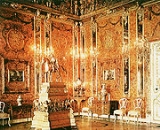
Amber Room
Encyclopedia
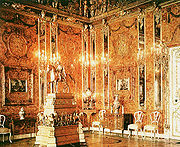
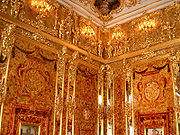
Catherine Palace
The Catherine Palace was the Rococo summer residence of the Russian tsars, located in the town of Tsarskoye Selo , 25 km south-east of St. Petersburg, Russia.- History :...
of Tsarskoye Selo
Tsarskoye Selo
Tsarskoye Selo is the town containing a former Russian residence of the imperial family and visiting nobility, located south from the center of St. Petersburg. It is now part of the town of Pushkin and of the World Heritage Site Saint Petersburg and Related Groups of Monuments.-History:In...
near Saint Petersburg
Saint Petersburg
Saint Petersburg is a city and a federal subject of Russia located on the Neva River at the head of the Gulf of Finland on the Baltic Sea...
is a complete chamber decoration of amber
Amber
Amber is fossilized tree resin , which has been appreciated for its color and natural beauty since Neolithic times. Amber is used as an ingredient in perfumes, as a healing agent in folk medicine, and as jewelry. There are five classes of amber, defined on the basis of their chemical constituents...
panels backed with gold
Gold
Gold is a chemical element with the symbol Au and an atomic number of 79. Gold is a dense, soft, shiny, malleable and ductile metal. Pure gold has a bright yellow color and luster traditionally considered attractive, which it maintains without oxidizing in air or water. Chemically, gold is a...
leaf and mirror
Mirror
A mirror is an object that reflects light or sound in a way that preserves much of its original quality prior to its contact with the mirror. Some mirrors also filter out some wavelengths, while preserving other wavelengths in the reflection...
s. Due to its singular beauty, it was sometimes dubbed the "Eighth Wonder of the World
Eighth Wonder of the World
Eighth Wonder of the World is a term sometimes used to describe things in comparison to the Seven Wonders of the World, the widely-known list of seven remarkable constructions of classical antiquity.-Natural places:...
".
Before it was lost, the original Amber Room represented a joint effort of German and Russian craftsmen. Construction of the Amber Room began in 1701 to 1709 in Prussia
Prussia
Prussia was a German kingdom and historic state originating out of the Duchy of Prussia and the Margraviate of Brandenburg. For centuries, the House of Hohenzollern ruled Prussia, successfully expanding its size by way of an unusually well-organized and effective army. Prussia shaped the history...
. The room was designed by German baroque sculptor Andreas Schlüter
Andreas Schlüter
Andreas Schlüter was a German baroque sculptor and architect associated with the Petrine Baroque style of architecture and decoration.-Biography:...
and constructed by the Danish amber craftsman Gottfried Wolfram and remained at Charlottenburg Palace
Charlottenburg Palace
Charlottenburg Palace is the largest palace in Berlin, Germany, and the only royal residency in the city dating back to the time of the Hohenzollern family. It is located in the Charlottenburg district of the Charlottenburg-Wilmersdorf burough.The palace was built at the end of the 17th century...
until 1716 when it was given by Prussian king Friedrich Wilhelm I
Frederick William I of Prussia
Frederick William I of the House of Hohenzollern, was the King in Prussia and Elector of Brandenburg from 1713 until his death...
to his then ally, Tsar
Tsar
Tsar is a title used to designate certain European Slavic monarchs or supreme rulers. As a system of government in the Tsardom of Russia and Russian Empire, it is known as Tsarist autocracy, or Tsarism...
Peter the Great
Peter I of Russia
Peter the Great, Peter I or Pyotr Alexeyevich Romanov Dates indicated by the letters "O.S." are Old Style. All other dates in this article are New Style. ruled the Tsardom of Russia and later the Russian Empire from until his death, jointly ruling before 1696 with his half-brother, Ivan V...
of the Russian Empire
Russian Empire
The Russian Empire was a state that existed from 1721 until the Russian Revolution of 1917. It was the successor to the Tsardom of Russia and the predecessor of the Soviet Union...
. In Russia it was expanded and after several renovations, it covered more than 55 square meters and contained over six tons of amber. The Amber Room was looted
Looted art
Looted art has been a consequence of looting during war, natural disaster and riot for centuries. Looting of art, archaeology and other cultural property may be an opportunistic criminal act, or may be a more organized case of unlawful or unethical pillage by the victor of a conflict."Looted art"...
during World War II
World War II
World War II, or the Second World War , was a global conflict lasting from 1939 to 1945, involving most of the world's nations—including all of the great powers—eventually forming two opposing military alliances: the Allies and the Axis...
by Nazi Germany
Nazi Germany
Nazi Germany , also known as the Third Reich , but officially called German Reich from 1933 to 1943 and Greater German Reich from 26 June 1943 onward, is the name commonly used to refer to the state of Germany from 1933 to 1945, when it was a totalitarian dictatorship ruled by...
and brought to Königsberg
Königsberg
Königsberg was the capital of East Prussia from the Late Middle Ages until 1945 as well as the northernmost and easternmost German city with 286,666 inhabitants . Due to the multicultural society in and around the city, there are several local names for it...
. Knowledge of its whereabouts was lost in the chaos at the end of the war.
In 1979 efforts began to rebuild the Amber room at Tsarskoye Selo
Tsarskoye Selo
Tsarskoye Selo is the town containing a former Russian residence of the imperial family and visiting nobility, located south from the center of St. Petersburg. It is now part of the town of Pushkin and of the World Heritage Site Saint Petersburg and Related Groups of Monuments.-History:In...
. In 2003, after decades of work by Russian craftsmen, financed by donations from Germany, the reconstructed Amber Room was inaugurated in the Catherine Palace in Saint Petersburg, Russia.
Creation
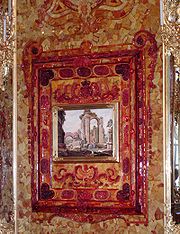
Charlottenburg Palace
Charlottenburg Palace is the largest palace in Berlin, Germany, and the only royal residency in the city dating back to the time of the Hohenzollern family. It is located in the Charlottenburg district of the Charlottenburg-Wilmersdorf burough.The palace was built at the end of the 17th century...
, home of Friedrich I
Frederick I of Prussia
Frederick I , of the Hohenzollern dynasty, was Elector of Brandenburg and Duke of Prussia in personal union . The latter function he upgraded to royalty, becoming the first King in Prussia . From 1707 he was in personal union the sovereign prince of the Principality of Neuchâtel...
, the first king of Prussia
Prussia
Prussia was a German kingdom and historic state originating out of the Duchy of Prussia and the Margraviate of Brandenburg. For centuries, the House of Hohenzollern ruled Prussia, successfully expanding its size by way of an unusually well-organized and effective army. Prussia shaped the history...
, at the urging of his second wife, Sophie Charlotte
Sophia Charlotte of Hanover
Sophia Charlotte of Hanover was the Queen consort of Prussia as wife of Frederick I of Prussia. She was the daughter of Ernst August, Elector of Hanover, and Sophia of the Palatinate...
. The concept of the room and its design was by Andreas Schlüter
Andreas Schlüter
Andreas Schlüter was a German baroque sculptor and architect associated with the Petrine Baroque style of architecture and decoration.-Biography:...
. It was crafted by Gottfried Wolfram, master craftsman
Artisan
An artisan is a skilled manual worker who makes items that may be functional or strictly decorative, including furniture, clothing, jewellery, household items, and tools...
to the Danish
Denmark
Denmark is a Scandinavian country in Northern Europe. The countries of Denmark and Greenland, as well as the Faroe Islands, constitute the Kingdom of Denmark . It is the southernmost of the Nordic countries, southwest of Sweden and south of Norway, and bordered to the south by Germany. Denmark...
court of King Frederick IV of Denmark
Frederick IV of Denmark
Frederick IV was the king of Denmark and Norway from 1699 until his death. Frederick was the son of King Christian V of Denmark and Norway and Charlotte Amalie of Hesse-Kassel .-Foreign affairs:...
, with help from the amber masters Ernst Schacht and Gottfried Turau from Danzig (now Gdańsk
Gdansk
Gdańsk is a Polish city on the Baltic coast, at the centre of the country's fourth-largest metropolitan area.The city lies on the southern edge of Gdańsk Bay , in a conurbation with the city of Gdynia, spa town of Sopot, and suburban communities, which together form a metropolitan area called the...
).
It did not, however, remain at Charlottenburg for long. Peter the Great admired it on a visit and in 1716, Friedrich Wilhelm I
Frederick William I of Prussia
Frederick William I of the House of Hohenzollern, was the King in Prussia and Elector of Brandenburg from 1713 until his death...
, the first king's son, presented it to him, and with that act cemented a Prussian-Russian alliance against Sweden
Sweden
Sweden , officially the Kingdom of Sweden , is a Nordic country on the Scandinavian Peninsula in Northern Europe. Sweden borders with Norway and Finland and is connected to Denmark by a bridge-tunnel across the Öresund....
.
The Amber Room represented a joint effort of German and Russian craftsmen. After several other 18th-century renovations, it covered more than 55 square meters and contained over six tonne
Tonne
The tonne, known as the metric ton in the US , often put pleonastically as "metric tonne" to avoid confusion with ton, is a metric system unit of mass equal to 1000 kilograms. The tonne is not an International System of Units unit, but is accepted for use with the SI...
s of amber. It took over ten years to construct.
World War II evacuation
Shortly after the beginning of the German invasion of the Soviet UnionSoviet Union
The Soviet Union , officially the Union of Soviet Socialist Republics , was a constitutionally socialist state that existed in Eurasia between 1922 and 1991....
in World War II (Operation Barbarossa
Operation Barbarossa
Operation Barbarossa was the code name for Germany's invasion of the Soviet Union during World War II that began on 22 June 1941. Over 4.5 million troops of the Axis powers invaded the USSR along a front., the largest invasion in the history of warfare...
), the curators responsible for removing the art treasures in Leningrad
Saint Petersburg
Saint Petersburg is a city and a federal subject of Russia located on the Neva River at the head of the Gulf of Finland on the Baltic Sea...
tried to disassemble and remove the Amber Room. Over the years the amber had dried out and become brittle, so that when they tried to remove it, the fragile amber started to crumble. The Amber Room was therefore hidden behind mundane wallpaper
Wallpaper
Wallpaper is a kind of material used to cover and decorate the interior walls of homes, offices, and other buildings; it is one aspect of interior decoration. It is usually sold in rolls and is put onto a wall using wallpaper paste...
, in an attempt to keep Nazi
Nazism
Nazism, the common short form name of National Socialism was the ideology and practice of the Nazi Party and of Nazi Germany...
forces from seizing it. However, the attempt to hide such a well-known piece of art failed.
German soldiers disassembled the Amber Room within 36 hours under the supervision of two experts. On 14 October 1941, Rittmeister Graf Solms-Laubach commanded the evacuation of 27 crates to Königsberg
Königsberg
Königsberg was the capital of East Prussia from the Late Middle Ages until 1945 as well as the northernmost and easternmost German city with 286,666 inhabitants . Due to the multicultural society in and around the city, there are several local names for it...
in East Prussia
East Prussia
East Prussia is the main part of the region of Prussia along the southeastern Baltic Coast from the 13th century to the end of World War II in May 1945. From 1772–1829 and 1878–1945, the Province of East Prussia was part of the German state of Prussia. The capital city was Königsberg.East Prussia...
, for storage and display in the town's castle. On 13 November 1941, the newspaper Königsberger Allgemeine Zeitung reported on an exhibition of part of the Bernsteinzimmer in Königsberg Castle
Königsberg Castle
The Königsberg Castle was a castle in Königsberg, Germany , and was one of the landmarks of the East Prussian capital Königsberg.- History :...
.
Last days in Königsberg
Orders by Hitler given on 21 January 1945 and 24 January 1945 allowed the movement of possessions. From that day onwards, Albert SpeerAlbert Speer
Albert Speer, born Berthold Konrad Hermann Albert Speer, was a German architect who was, for a part of World War II, Minister of Armaments and War Production for the Third Reich. Speer was Adolf Hitler's chief architect before assuming ministerial office...
's administration could move culture goods of priority "I (o)". Erich Koch
Erich Koch
Erich Koch was a Gauleiter of the Nazi Party in East Prussia from 1928 until 1945. Between 1941 and 1945 he was the Chief of Civil Administration of Bezirk Bialystok. During this period, he was also the Reichskommissar in Reichskommissariat Ukraine from 1941 until 1943...
was in charge in Königsberg. Eyewitnesses claimed that crates had been sighted at the railway station. They might have been put aboard the Wilhelm Gustloff
Wilhelm Gustloff (ship)
The MV Wilhelm Gustloff was a German KdF flagship during 1937-1945, constructed by the Blohm & Voss shipyards. It sank after being torpedoed by the Soviet submarine on 30 January 1945....
which left Gotenhafen (Gdynia)
Gdynia
Gdynia is a city in the Pomeranian Voivodeship of Poland and an important seaport of Gdańsk Bay on the south coast of the Baltic Sea.Located in Kashubia in Eastern Pomerania, Gdynia is part of a conurbation with the spa town of Sopot, the city of Gdańsk and suburban communities, which together...
on 30 January 1945, and was sunk by a Soviet submarine.
In the summer of 1944, Königsberg was heavily bombed by the Royal Air Force
Royal Air Force
The Royal Air Force is the aerial warfare service branch of the British Armed Forces. Formed on 1 April 1918, it is the oldest independent air force in the world...
. It suffered further extensive damage at the hands of the advancing Soviets before and after its fall on 9 April 1945. It remained thereafter under Soviet control, eventually renamed Kaliningrad. The remains of the castle were destroyed by the Red Army during the 1960s.
Disappearance and mystery
The Amber Room was never seen again, though reports have occasionally surfaced stating that components of the Amber Room survived the war. Indeed, two elements of the room's decoration (but not the amber panels themselves) were eventually rediscovered (see below).There have been numerous conflicting reports and theories, among them that the Amber Room was destroyed by bombing, hidden in a now-lost subterranean bunker in Königsberg, buried in mines in the Ore Mountains, or taken onto a ship or submarine
Submarine
A submarine is a watercraft capable of independent operation below the surface of the water. It differs from a submersible, which has more limited underwater capability...
which was sunk by Soviet forces in the Baltic Sea
Baltic Sea
The Baltic Sea is a brackish mediterranean sea located in Northern Europe, from 53°N to 66°N latitude and from 20°E to 26°E longitude. It is bounded by the Scandinavian Peninsula, the mainland of Europe, and the Danish islands. It drains into the Kattegat by way of the Øresund, the Great Belt and...
.
Many different individuals and groups, including a number of different entities from the government of the Soviet Union, have mounted extensive searches for it at various times since the war, without any success. At one point in 1998, two separate teams (one in Germany, the other in Lithuania) announced that they had located the Amber Room, the first in a silver mine, the second buried in a lagoon
Lagoon
A lagoon is a body of shallow sea water or brackish water separated from the sea by some form of barrier. The EU's habitat directive defines lagoons as "expanses of shallow coastal salt water, of varying salinity or water volume, wholly or partially separated from the sea by sand banks or shingle,...
; neither produced the Amber Room.
However, in 1997 one Italian stone mosaic that was part of a set of four which had decorated the Amber Room did turn up in western Germany
Germany
Germany , officially the Federal Republic of Germany , is a federal parliamentary republic in Europe. The country consists of 16 states while the capital and largest city is Berlin. Germany covers an area of 357,021 km2 and has a largely temperate seasonal climate...
, in the possession of the family of a soldier who had helped pack up the Amber Room.
Destruction theory
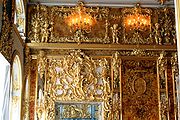
Documents from the archives showed that that was also the conclusion of the report of Alexander Brusov, chief of the first formal mission sent by the Soviet government to find the Amber Room, who wrote in June, 1945: "Summarizing all the facts, we can say that the Amber Room was destroyed between 9 and 11 April 1945". Some years later, Brusov gave a contrary opinion; the book authors insinuate that this change of opinion was likely due to pressure from other Soviet officials, who did not want to be seen as responsible for the loss of the Amber Room.
Among other information from the archives was the revelation that the remains of the rest of the set of Italian stone mosaics were found in the burned debris of the castle. The authors' reasoning as to why the Soviets conducted extensive searches for the Amber Room in the years after WWII, even though their own experts had concluded that it was destroyed, is that it served the differing motives of several elements in the Soviet government: some wished to obscure (even from other branches of the Soviet government) the fact that Soviet soldiers may have been responsible for its destruction; others found the theft of the Amber Room a useful Cold War
Cold War
The Cold War was the continuing state from roughly 1946 to 1991 of political conflict, military tension, proxy wars, and economic competition between the Communist World—primarily the Soviet Union and its satellite states and allies—and the powers of the Western world, primarily the United States...
propaganda
Propaganda
Propaganda is a form of communication that is aimed at influencing the attitude of a community toward some cause or position so as to benefit oneself or one's group....
tool, and did not want to let go of a grievance that could be aired advantageously; still others did not want to share the blame for its destruction (through their failure to evacuate the Amber Room to safety at the start of the war).
Russian officials have denied the book's conclusions - angrily, in some cases. According to Adelaida Yolkina, senior researcher at the Pavlovsk Museum Estate: "It is impossible to see the Red Army being so careless that they let the Amber Room be destroyed." Other Russian experts were less sceptical, and had a different emphasis in their responses. Mikhail Piotrovsky, director of the State Hermitage Museum
Hermitage Museum
The State Hermitage is a museum of art and culture in Saint Petersburg, Russia. One of the largest and oldest museums of the world, it was founded in 1764 by Catherine the Great and has been opened to the public since 1852. Its collections, of which only a small part is on permanent display,...
, was very cautious in his comments, and said: "Most importantly, the destruction of the Amber Room during the Second World War is fault of the people who started the war". In reply, Catherine Scott-Clark, one of the authors, indicated that they only came to their conclusions with reluctance: "when we started working on this issue we were hoping to be able to find the Amber Room."
Since the book came out, a Russian veteran has given an interview in which he confirmed their basic conclusion as to the fate of the Amber Room, although he denies that the fires were deliberate. "I probably was one of the last people who saw the Amber Room", said Leonid Arinshtein, a literature expert with the nongovernmental Russian Culture Foundation, who was a Red Army lieutenant in charge of a rifle platoon in Königsberg in 1945. "The Red Army didn't burn anything", he said.
A variation of this theory is common currency amongst present-day residents of Kaliningrad. This is that part at least of the room was found in the cellars after WWII by the Red Army, in relatively good condition. This was not admitted at the time in order that blame should continue to rest upon the Germans. To preserve this story access to the ruins of the castle, which were substantial after WWII, was restricted, even to historical/archaeological surveys. During the 1960s, access to the site was suddenly withheld and the ruins were blown up by the Army, sealing any access to the underground area. The Dom Sovetov was built over the central area. The remains of the room may still be sited underground; however, as mentioned above, amber which is not cared for will crumble into dust. It is presumed that this is what has happened and that the Russian authorities, even after Communism, have been unwilling to admit this.
Reconstructions
- In KleinmachnowKleinmachnowKleinmachnow is a municipality in the Potsdam-Mittelmark district, in Brandenburg, Germany.-Geography:It is situated southwest of the centre of Berlin, immediately neighbouring the borough of Steglitz-Zehlendorf, and east of Potsdam...
, near Berlin, there is a miniature Amber Room, fabricated after the original. The Berlin miniature collector Ulla Klingbeil had this copy made of original East PrussiaEast PrussiaEast Prussia is the main part of the region of Prussia along the southeastern Baltic Coast from the 13th century to the end of World War II in May 1945. From 1772–1829 and 1878–1945, the Province of East Prussia was part of the German state of Prussia. The capital city was Königsberg.East Prussia...
n amber. The exhibit fee at Europarc Dreilinden is donated to the Arilex-Verein Foundation to aid handicapped children.
- In 1979 a reconstruction effort began at Tsarskoye SeloTsarskoye SeloTsarskoye Selo is the town containing a former Russian residence of the imperial family and visiting nobility, located south from the center of St. Petersburg. It is now part of the town of Pushkin and of the World Heritage Site Saint Petersburg and Related Groups of Monuments.-History:In...
, based largely on black and white photographs of the original Amber Room. Financial difficulties to the project were solved with USD $3.5 million donated by the GermanGermanyGermany , officially the Federal Republic of Germany , is a federal parliamentary republic in Europe. The country consists of 16 states while the capital and largest city is Berlin. Germany covers an area of 357,021 km2 and has a largely temperate seasonal climate...
company Ruhrgas AG. By 2003, the titanic work of the Russian craftsmen was mostly completed. The new room was dedicated by Russian President Vladimir PutinVladimir PutinVladimir Vladimirovich Putin served as the second President of the Russian Federation and is the current Prime Minister of Russia, as well as chairman of United Russia and Chairman of the Council of Ministers of the Union of Russia and Belarus. He became acting President on 31 December 1999, when...
and German Chancellor Gerhard SchröderGerhard SchröderGerhard Fritz Kurt Schröder is a German politician, and was Chancellor of Germany from 1998 to 2005. A member of the Social Democratic Party of Germany , he led a coalition government of the SPD and the Greens. Before becoming a full-time politician, he was a lawyer, and before becoming Chancellor...
at the 300-year anniversary of the city of Saint Petersburg.
Appearances in fiction
The mystery of the Amber Room has been the basis for the plot of several films, books and art exhibitions.- The Amber Room, novel by T. Davis BunnT. Davis BunnT. Davis Bunn is an American author.Bunn grew up in North Carolina. He became an international financial expert and worked in Europe, Africa and the Middle East. Bunn and his wife live in Oxford now...
- The Amber Room, novel by Steve Berry
- The Amber Room, novelette by Ian WatsonIan Watson (author)Ian Watson is a British science fiction author. He currently lives in Northamptonshire, England.His first novel, The Embedding, winner of the Prix Apollo in 1975, is unusual for being based on ideas from generative grammar; the title refers to the process of center embedding...
- Death in Amber, novel by Dean Fetzer
- Amber Beach, by Elizabeth Lowell
- "The Amber Secret" Novel by Peter Slaney
- The Black SunThe Black Sun (James Twining)The Black Sun is a 2005 historical novel by British author James Twining dealing with Nazism and occultism, Die Glocke and stolen Jewish art....
, by James TwiningJames TwiningJames Twining is a British thriller writer.- Life :Although born in London, Twining spent most of his childhood in France after his family moved to Paris when he was four... - The Devil Dances for Gold by Regina Ross
- Mosaic, by Gayle LyndsGayle LyndsGayle Lynds is an American author. A member of the U.S. Association for Intelligence Officers, she is known for being a bestselling novelist in the male-dominated genre of spy fiction or spy thrillers...
- "Cold Hit", by Linda FairsteinLinda FairsteinLinda Fairstein is an American feminist author and former prosecutor focusing on crimes of violence against women and children. She served as head of the sex crimes unit of the Manhattan District Attorney's office from 1976 until 2002 and is the author of a series of novels featuring Manhattan...
- The 39 CluesThe 39 CluesThe 39 Clues consists of two series of adventure books, The Clue Hunt and Cahills vs. Vespers, combining reading, online gaming, and card collecting...
: The Black CircleThe Black CircleThe Black Circle is the fifth book in The 39 Clues series and is written by Patrick Carman. This book was released on August 11, 2009. Amy and Dan Cahill, the protagonists of the series, try to follow a Lucian secret...
, by Patrick CarmanPatrick CarmanPatrick Carman is an American author of the The Land of Elyon series, the Atherton series, the Elliot's Park series, the Skeleton Creek Saga, and the fifth 39 Clues book. His books have been translated into approximately two dozen languages.-Biography:Patrick Carman was born on February 27, 1966,... - El salón de ámbar by Matilde AsensiMatilde AsensiMatilde Asensi is a Spanish journalist and writer, specialised mainly in historical novels.Asensi was born at Alicante.She studied journalism at the Autonomous University of Barcelona, and she later worked for three years in the service of news of Radio Alicante-SER and Radio Nacional de España ...
- The Brutal Telling by Louise PennyLouise PennyLouise Penny is a Canadian author of mystery novels set in the Canadian province of Quebec centred on the work of Inspector Armand Gamache of the Sûreté du Québec. Penny's first career was as a radio broadcaster for the Canadian Broadcasting Corporation...
- The USA Network television series, White CollarWhite Collar (TV series)White Collar is a USA Network television series created by Jeff Eastin, starring Matt Bomer as con-man Neal Caffrey and Tim DeKay as Special Agent Peter Burke. It premiered on October 23, 2009. In December 2009, White Collar was renewed for a second season that began on July 13, 2010...
, refers to the Amber Room extensively, especially in in episode 1x08, Hard Sell. It is revealed to one of the series' protagonists, Neal Caffrey, that his nemesis, "The Man With The Ring", and his former lover, Kate Moreau, want an amber music box that is supposedly a remnant of the room. The alleged reason is that the box, while not overly valuable in its own right, contains some kind of secret information. Caffrey is assumed to have stolen the music box (he did not actually do so), and must locate the box in order to free Kate from "The Man With the Ring".
Citations
External links
- Bibliographical Database of the International literature about the Amber Room by Peter Bruhn
- Amber Room Recreation - Recollection of an Eye-witness
- AmberRoom.Org: History, Photographs and Research
- The Amber Room: Tears of the Gods
- Mysteries of the Lost Amber Room
- On the Trail of The Amber Room - BBC, August 1, 1998
- Peter the Great's amber room reborn - BBC, 14 May 2003
- New theory on Russian art riddle BBC, 24 May 2004
- What to do with a German treasure - APM Market Place 21 Feb, 2008
- Outrage At Amber Room Book Saint Petersburg Times
- Mystery of the Amber Room resurfaces MSNBC
- The Amber Room on the Web
- Photos Of Amber Room Good Morning America

